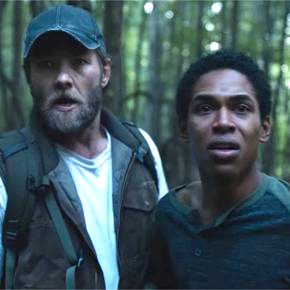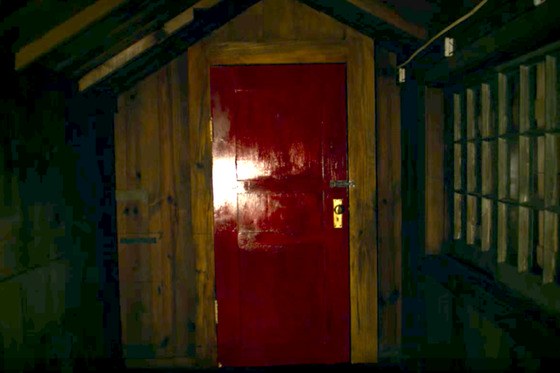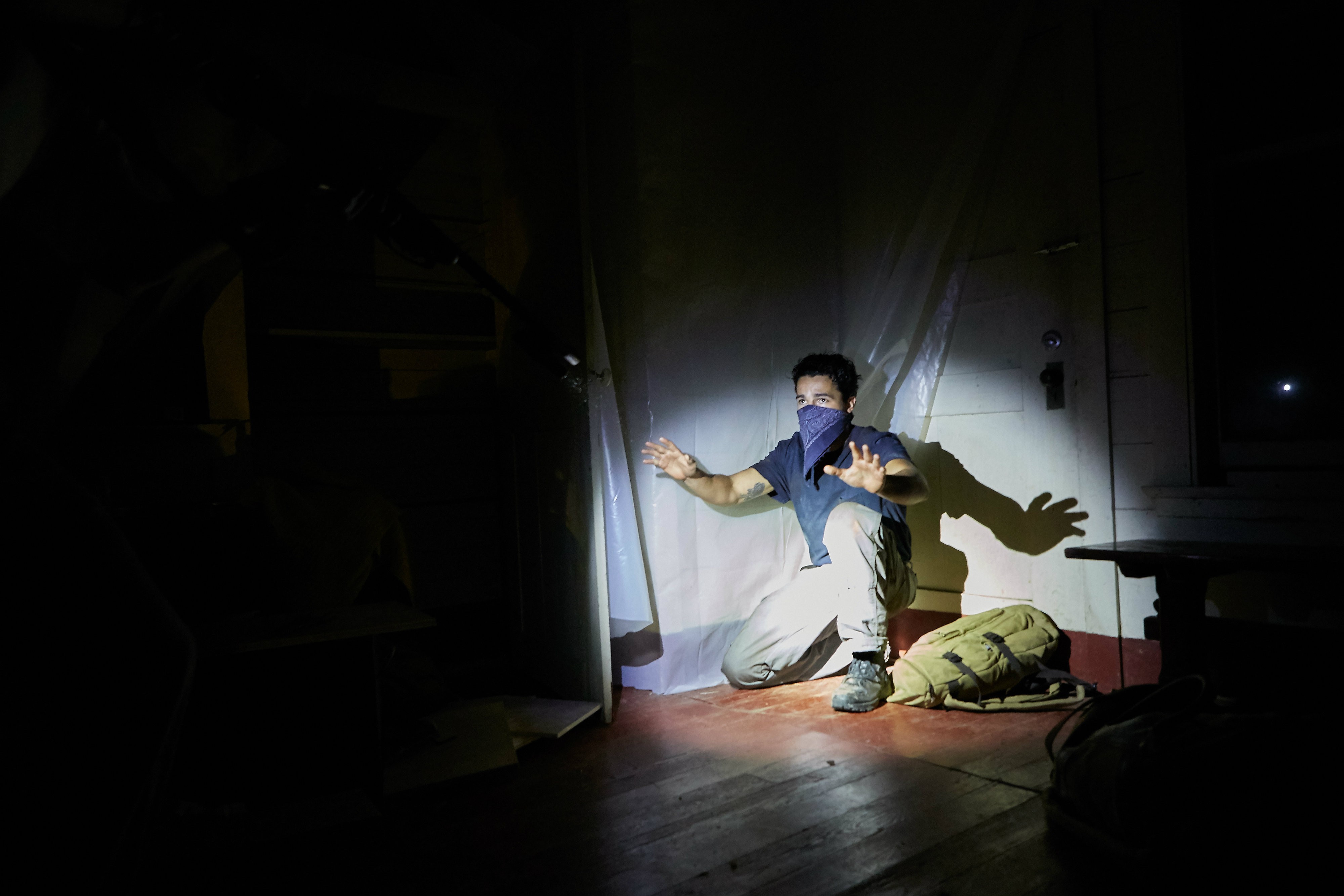
If you’ve caught any trailers for It Comes at Night, you know it’s a scary one. I went to see it the other day, and, preparing for the worst, I took a seat near the back and nestled in behind my popcorn. Sensing a particularly horrific part coming, I fixed my eyes at a corner of the screen. Alas the scares came too suddenly for me to look away, but for the most part, I didn’t want to. In Trey Edward Shults’ second feature, not all was as it seemed. It Comes at Night promised something sinister lurking outside the red door of the safe house, but what it revealed in the hearts of the family inside was far darker.
 Shored up in their home with enough supplies and weaponry to survive for some time, Joel Edgerton’s Paul, his wife and their seventeen-year-old son try to protect themselves from a mysterious plague. The action starts right away as Paul, the scared patriarch, carts his ill father-in-law, down with the deathly sickness, to a pre-dug grave. He muffles the kill-shot with a pillow and rolls the body into its final resting place like a clumpy piece of sod. He sets the corpse ablaze and watches the flame for a moment before moving back to the house. His teenage son, grandson of the deceased, isn’t as hardened to the fact though. Based on Edgerton’s strict ground rules, designed to ensure survival and prevent infection, he took Travis with him to carry out the task. Always travel outside the house in twos, he says. Kelvin Harrison, Jr. plays the raw, mouth-agape adolescent who probably wasn’t prepared to see a beloved family member dispatched so coldly. Who would be?
Shored up in their home with enough supplies and weaponry to survive for some time, Joel Edgerton’s Paul, his wife and their seventeen-year-old son try to protect themselves from a mysterious plague. The action starts right away as Paul, the scared patriarch, carts his ill father-in-law, down with the deathly sickness, to a pre-dug grave. He muffles the kill-shot with a pillow and rolls the body into its final resting place like a clumpy piece of sod. He sets the corpse ablaze and watches the flame for a moment before moving back to the house. His teenage son, grandson of the deceased, isn’t as hardened to the fact though. Based on Edgerton’s strict ground rules, designed to ensure survival and prevent infection, he took Travis with him to carry out the task. Always travel outside the house in twos, he says. Kelvin Harrison, Jr. plays the raw, mouth-agape adolescent who probably wasn’t prepared to see a beloved family member dispatched so coldly. Who would be?
Edgerton’s carriage is typical of the emotional dysfunction we see in the film. He appears to be doing the right thing, but it’s at the cost of his humanity. “You can’t trust anybody but family,” he preaches to his son. This proves toxic when another family comes to stay in the house and the trust amongst the original trio is tested. Here, the filmmaker delves into the ways we deal, or choose not to deal, with loss. Hunkering down and turning inward, building safe houses and cautionary lists, is often the easiest thing, but rarely is it the healthiest.
If the brutal opening scene is any indication, It Comes at Night is steeped in violence. The characters are rarely without weapons, and they wear dehumanizing gas masks when they venture outside. We can’t make out facial expressions underneath the masks, so they turn the actors into frightening machines, capable of unspeakable things. Joel Edgerton’s Paul is a history teacher who shakes terribly when a threat is near, so it’s with some effort he’s hardened himself into a man capable of pulling the trigger. This is resonant to those of us who’ve wondered how’d we respond to a zombie apocalypse, or even imagined ourselves into a scenario like Stephen King’s The Stand because Paul looks like an everyman. After a violent episode, he asks his victim, strikingly, “Are we good?” Battered and bloodied, the man tries to piece together a response. (Of course, he’s not good! You just beat him senseless and tied him to a tree!) Yet, it’s a realistic question in the moment, and one that I’ve asked plenty of times myself; a thin apology that attempts to exonerate the apologizer and doesn’t accomplish much else. Even when we’ve wounded each other irreparably, we find it appropriate to ask, “Are we good?”

One episode with Edgerton’s trained indifference to brutality stands out. On an impromptu expedition, a shot whizzes by his head in the cab of his pickup truck, and he veers off the road. A brief gunfight ensues, Edgerton’s skittishness shows but he takes down his attackers with accurate marksmanship. One man is left alive, and he has the opportunity to question him, maybe figure out what the heck is going on in the woods at night. But before the fallen man can talk, Edgerton freaks and kills him. He starts a panicky yelling match with his companion, a temporary ally. “Why’d you do that?” the other man shouts. The clear answer, the audience intuits, is that he did it because he was scared out of his wits. But there’s no way he can say that. He spouts some paranoia-riddled nonsense about the disease, and they climb back in the car. The movie’s littered with these types of rationalizations. His explanation for shooting the man doesn’t matter. The level of fear that drove him to repress his feelings and respond so violently is what’s interesting.
The details of the plague, or what actually comes in the night, remain fuzzy. Therefore, and Shults has said this in interviews, it’s not a stretch to connect the “it” of the title with our anxieties and hurts. Why am I arguing with a dear friend? Why am I afraid to be vulnerable with someone? Why is it hard to talk about a dead relative? Is it because I fear I’m all alone, that I can’t trust anybody but family? Maybe it’s all related to a fear of death – that none of this really matters. It sounds a little dramatic, but It Comes at Night pushes us to this place. By the end, Travis, the teenager whose nightmares we watch in terror, comes to question even these familial bonds. I won’t spoil it, but the ending sticks with you, and feels hauntingly inevitable. The dread that dominates the movie, making us long for the daylight that will put an end to fearful night, is none other than our fear of death, the horror of contemplating oblivion without consciousness.

COMMENTS
2 responses to “It Comes at Night and the Fear of Grief”
Leave a Reply














great write up of a great movie — actually liking it more after reading this. thanks dp.
Thx, David.